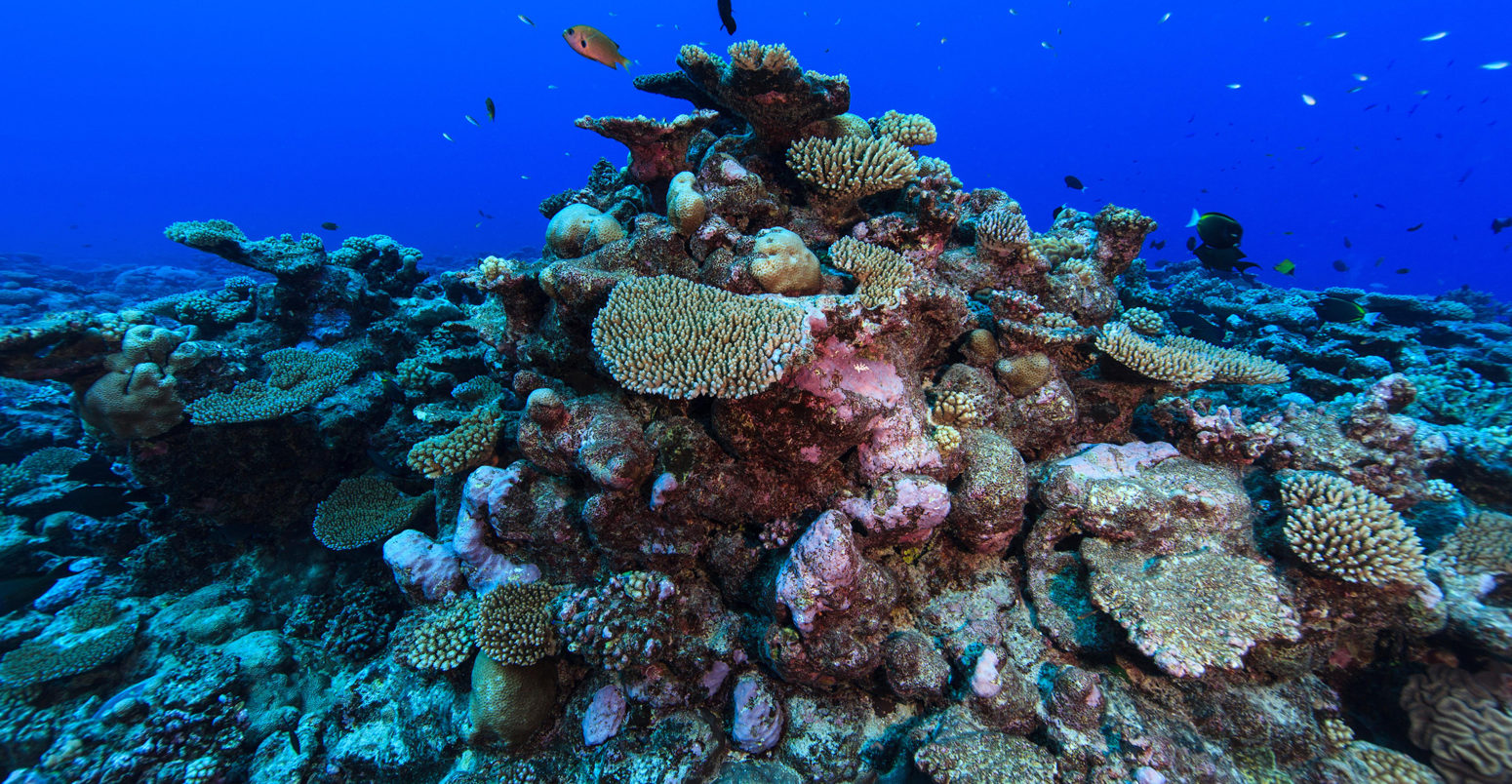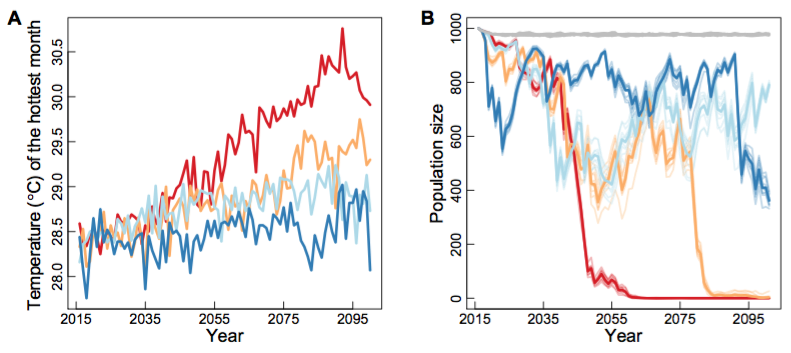
Rapid CO2 cuts could allow some cool-water corals to adapt to global warming
Daisy Dunne
11.01.17Daisy Dunne
01.11.2017 | 6:00pmSome of the world’s most diverse coral reefs are found in cooler parts of the tropics. These corals may be able to adapt to rising temperatures if future greenhouse gas emissions are drastically reduced, a new study suggests.
The modelling study simulates the effect of climate change on the survival of one population of a single coral species found off the coast of Rarotonga in the Cook Islands in the South Pacific. The researchers find that the genetic makeup of some cool-water corals might allow them to adapt to gradual increases in temperature.
However, without rapid cuts to emissions, the rate of climate change will likely outpace the ability of the corals to adapt, the study finds, resulting in the extinction of many coral populations by the end of the century.
More research will be needed to see if other cool-water corals around the world also hold the genetic code needed to adapt, another scientist tells Carbon Brief.
Fight for survival
Coral reefs make up some of the most ecologically important habitats in the world. Despite covering just 0.1% of the ocean floor, reefs help to support around 25% of marine species.
However, these diverse environments are vulnerable to climate change. This is because high sea temperatures causes coral bleaching, which is when corals expel the tiny colourful algae living in their tissues – known as zooxanthellae – leaving behind a stark white skeleton.
The algae provide the corals with energy through photosynthesis. Without them, the corals starve. Although corals can recover from a bleaching event, persistent bleaching can kill off entire reefs, leaving hundreds of thousands of marine species without a home.
But the new study, published in Science Advances, offers a glimmer of hope. It finds that this type of cool-water coral may be able to adapt to a rise in temperatures, if emissions are drastically cut in the coming decades.
For the study, the researchers concentrated their efforts on one population of a coral found in Rarotonga. The coral that lives here is called Acropora hyacinthus, which is a species considered to be “near threatened” by the International Union for the Conservation of Nature (IUCN).
In Rarotonga, corals live in relatively cool waters, says Dr Rachael Bay, lead author of the study from California State University. She tells Carbon Brief:
“It’s about 21 degrees south latitude which is towards the southern boundary of coral growth. So that population would be a considered a fairly cool reef, but then the question becomes, would that reef be able to adapt as temperatures warm up?”
Thermal tolerance
To find out if the corals could possibly evolve to adapt to climate change, the researchers first needed to assess whether the organisms possessed the right genetic material to allow them to cope with heat stress.
The researchers collected samples from 30 coral colonies across the island and used genetic techniques to scan the animals’ genomes, looking for specific variants of genes that are known to promote thermal tolerance in corals.
They found that a small proportion of corals living in Rarotonga do possess favourable variants of genes that convey tolerance to heat. This means that it is possible that, under the right conditions, the animals may be able to adapt to warming sea temperatures.
Model simulations
For the second part of the study, the researchers used computer simulations to estimate how quickly the corals could adapt to warming temperatures under a range of emissions scenarios. These included a relatively low emissions scenario (RCP2.6), an intermediate emissions scenario (RCP4.5), a moderately high emissions scenario (RCP6.0) and a high emissions scenario (RCP8.5).
You can read more about the four “RCPs”, or “Representative Concentration Pathways”, here. At present, global emissions are tracking closest to RCP8.5, the highest of the four.
The results show that coral populations simulated under RCP2.6 and RCP4.5 survive until 2100. However, under both RCP6.0 and RCP8.5, coral populations go extinct before the end of the century.
You can see this in chart B below, which shows the estimated coral population size from 2015 to 2100 under RCP2.6 (dark blue), RCP4.5 (light blue), RCP6.0 (orange) and RCP8.5 (red). The grey shows a scenario with no future warming. Chart A shows the estimated rise in the temperature of the hottest month from present until 2100 under each scenario.

A shows the estimated rise in temperature of the hottest month from present until 2100 under RCP2.6 (dark blue), RCP4.5 (light blue), RCP6.0 (orange) and RCP8.5 (red). B shows the estimated coral population size from 2015 to 2100 under each scenario. Source: Bay et al. (2017)
In the simulations under RCP2.6, the fraction of genetic variants conveying thermal tolerance steadily increases as temperatures rise. The rise suggests that heat-tolerant individuals are able to survive and reproduce, passing on their favourable genes to their offspring. So after an initial fall in coral population as temperatures rise, the simulations show the population recovering as the proportion of heat-tolerant individuals increases.
Under RCP4.5, coral populations do not initially adapt to the warming conditions, falling below 600 individuals between 2035 and 2065. At this point, only the most heat-tolerant individuals are able to survive. These individuals are able to reproduce and pass on their genes to their offspring, which led to a higher proportion of heat-tolerant corals, and a gradual recovery in the population.
But in simulations under both RCP6.0 and RCP8.5, the rate of warming is too fast for adaptation to take place. This is because heat-tolerant animals are likely to die before they have a chance to reproduce and pass on their genes to their offspring.
One location
Although the results suggest there is hope for some corals, the study only considers how climate change could affect one population at one location. Therefore, not all types of cool-water corals will be able to adapt in the same way, Bay cautions:
“While our results do specifically speak to one species in one location and that we certainly need further information on other species, people have found climate-associated genetic variation in other species, which means that they have potential to adapt. But we can’t really say without doing this kind of study how quickly that would happen.”
The research also highlights that there are important limits to adaptation, says Dr Mark Eakin, a coral specialist from the National Oceanic Atmospheric Administration (NOAA) and coordinator of NOAA’s Coral Reef Watch programme. He tells Carbon Brief:
“It’s clear that the corals are doing their part in trying to keep up with a warming ocean, but their survival requires that we all act quickly to not only stop – but also reverse – the excess CO2 we are dumping into the atmosphere. Unless we rapidly reduce global warming, corals won’t be able to adapt quickly enough to keep up.”
“More work is needed before we can generalise these results to the hundreds of coral species around the world.”
Bay, R. A. et al. (2017) Genomic models predict successful coral adaptation if future ocean warming rates are reduced, Science Advances, http://advances.sciencemag.org/content/3/11/e1701413
-
Rapid CO2 cuts could allow some cool-water corals to adapt to global warming

